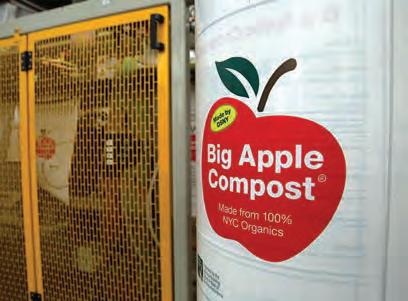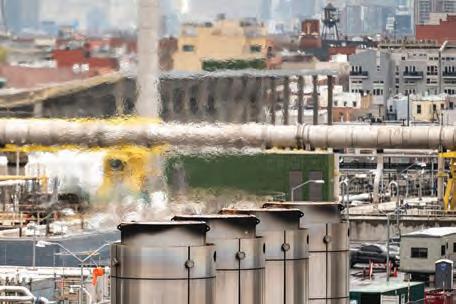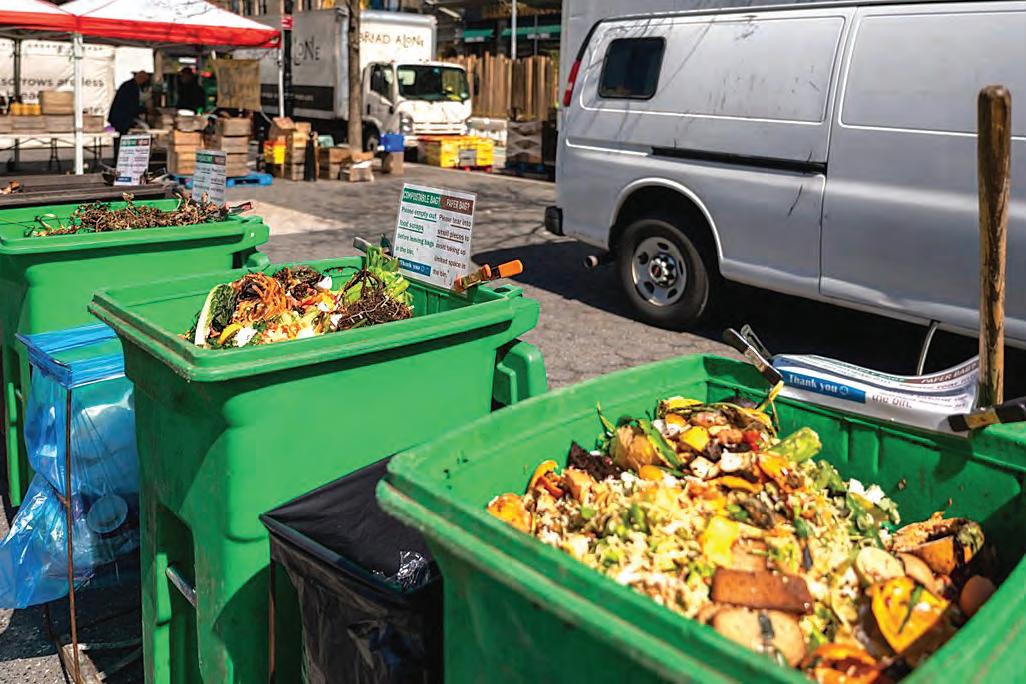
5 minute read
Less compost, more methane gas and landfill loom
City-funded food-scrap programs face potential shutdown with budget cuts
by Samantha Maldonado THE CITY
This article was originally published on Nov. 28 at 5:00 a.m. EDT by THE
CITY
The city Department of Sanitation proposal to eliminate funding for community composting means most food waste collected through public programs will become gas or landfill, not compost.
Under proposed budget cuts as part of a wider agenda to trim city spending, community compost organizations — GrowNYC, the Lower East Side Ecology Center, BIG Reuse and Earth Matter, as well as the four botanical gardens — must shut down their city-funded programs by the end of the year.
At over 200 collection sites in the five boroughs, community composters currently collect scraps and send the material to be composted locally — that is, broken down into nutrient-rich fertilizer or mulch used to make soil healthier.
But the DSNY’s own foodscrap collection programs — including a curbside pickup program — work differently. In most of the city, food scraps placed in orange street corner bins and in brown curbside containers are not actually composted.
Instead, most of the scraps get turned into a slurry, added to wastewater sludge and digested at the Newtown Creek Wastewater Resource Recovery Facility, a Brooklyn sewage treatment plant. Other food waste gets digested in western Massachusetts to create energy and farm fertilizer.
The digestion process generates biogas, which is mostly the potent greenhouse gas methane, and helps power the Newtown Creek treatment plant itself. The biogas is supposed to service nearby homes, but as THE CITY has pre- viously reported, that project experienced epic delays. For almost a decade as the project stalled, excess methane was burned off instead.

On Staten Island, food scraps in Smart Bins get composted at the DSNY’s facility there. In the other boroughs, New Yorkers must compost their organic waste themselves or pay for services to do it for them — unless they bring their scraps to community compost drop-off sites.
“There is space for both composting and other means of processing organic waste,” said Justin Green, executive director of Big Reuse. “By eliminating the current composting sites, we take a step backwards in terms of rolling out more composting infrastructure.”
Flaring off food waste
Organic material makes up about a third of New York City’s waste stream. Diverting it from landfills reduces emissions of planet-warming methane as the material rots and removes ratattracting food waste from garbage in bags awaiting pickup.
The budget cuts could result in 115 job losses, GrowNYC claims in a petition demanding the administration of Mayor Eric Adams keep the community composting program.
Green said that two of the three sites Big Reuse runs — in Gowanus and under the Queensboro Bridge — are dependent on city support and would need to be shut down. He added that the third site at Red Hook Farms would continue but would likely see its composting capacity severely curtailed without a Big Reuse staff member.
In remarks made last week, Adams said he was “angry also” about the budget cuts, which he said were necessary because of the expense of providing assistance to migrants.
Community composting makes up just over 10 percent of the overall $33 million annual composting budget, according to DSNY.
“You can watch that apple core turn into this crumbly material and then use it in your community garden to grow more food with it. That’s the magic and power of community composting,” said Christine Datz-Romero, executive director of the Lower East Side Ecology Center. “It’s the direct circle of what we can create and it’s what we need to do in cities.”
Since the 1990s, the Ecology Center has offered places for New Yorkers drop off food scraps. Now it runs 20 collection sites, including the Union Square Greenmar- ket, and processes the scraps to make compost. Datz-Romero said the cuts would result in a loss of 11 jobs at the organization.

The Newtown Creek Wastewater treatment plant project, a partnership between the city Department of Environmental Protection and National Grid, was proposed in 2013 and aimed to feed biogas into local homes to avoid carbon emissions and replace fracked gas. The utility company would install equipment to purify the biogas and inject it into the gas system.
But any excess methane that can’t be used is flared, which releases carbon dioxide into the atmosphere. If the National Grid project were to operate the way it was designed, flaring biogas would be “virtually” eliminated, according to a document obtained by THE CITY.
After almost a decade of delays, the project began “consistently” providing gas into the distribution system at the end of March and shut down “automatically” in August, said National Grid spokesperson Karen Young.
“We conducted an assessment with our independent specialists and found vibrations from the rotating equipment and impacts to the flow rate of biogas,” she wrote in an email, adding the system is now back online and working as originally designed.
To Vandra Thorburn, a member of the Brooklyn Solid Waste Advisory Board and founder of Vokashi, a small company that composts organics for a fee, turning food scraps into biogas is not the most sustainable approach.
“We need soil and we don’t need to be flaring off food waste. It’s graying instead of greening the city,” she said.
The digestion process at the Newtown Creek plant also produces solids in addition to the gas.
According to the DEP, less than half of those solids are converted into a nutrientrich fertilizer for soil. The rest gets landfilled.
But even though most of the curbside and smart bin material doesn’t actually get composted, getting New Yorkers to divert food scraps from the trash is important, Datz-Romero said.
“We want people to start getting into the habit. We want people to separate their organic material from the rest of the trash,” she said. “Am I happy about anaerobic codigestion at Newtown Creek? No, I think the city can do a lot better. I call it the lazy route.”
NYC’s #1 enemy
The proposed cuts will also result in the delay of curbside organic collection in Staten Island and the Bronx, first scheduled for April 2024, until October of that year, when Manhattan is also slated to get the service.
Department of Sanitation spokesperson Robin Levine indicated the Adams administration is “on track to deliver composting services” to all New Yorkers by next year.
“By reducing the food waste that we put into trash bags, our streets will look better and smell better, and best of all, we will be dealing a blow to New York City’s number one enemy: rats,” she said in a statement.
The network of community composters conducts educational outreach, including about the brown bin program. That work will help ensure the collection program’s success, said Green.
“Most of the people we talk to aren’t even aware of the program still,” Green said. “It will take a lot of time to talk to people and educate them on how to participate in the curbside program. It helps to have face-to-face interactions with as many people as possible.” Q
THE CITY (www.thecity.nyc) is an independent, nonprofit news organization dedicated to hardhitting reporting that serves the people of New York.








